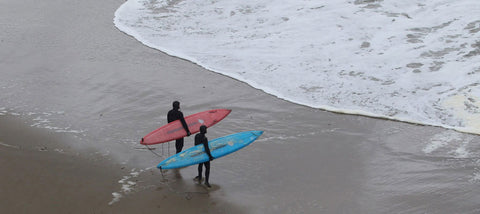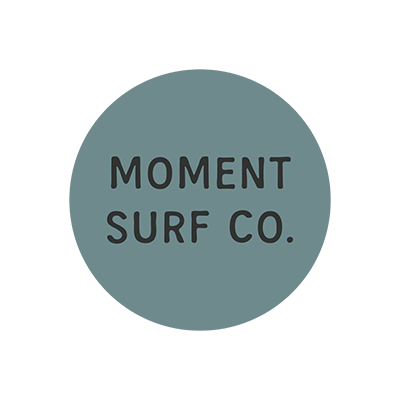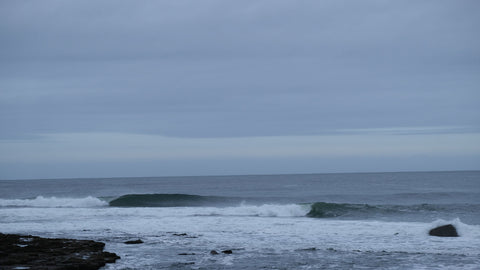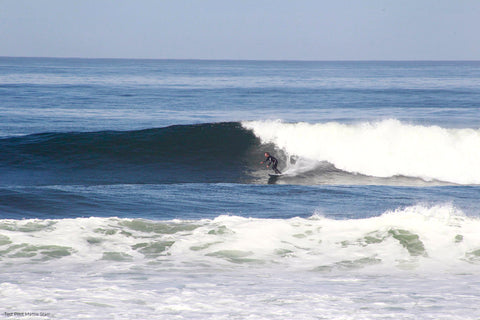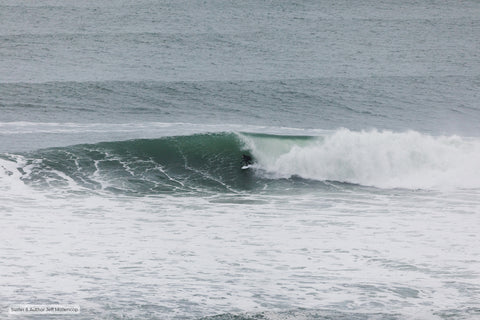If you don’t take any risks, are you truly living? By spending your life playing it safe, you miss out on experiences that challenge you and help you grow as a person. Every great artist or musician has created something that didn’t sell. All successful businesses have built a product at one point that didn’t work as designed. With big wave surfing however, the penalty for making a mistake can be life threatening. Choosing the wrong wave, having a board that doesn’t perform, or being out of position when a set rolls through, can all lead to serious consequences. Picking which days to paddle out can mean the difference between the wave of your life, or the one that takes it. It’s not for your typical surfer. The dedication and drive it takes to challenge large surf means making sacrifices in other areas of your life. To these special individuals, “surf comes first” can mean the difference between life and death.

Jeremy and Tony wait patiently before paddling out.
For team riders Tony Perez, Jeremy Rasmussen, and Tyler Cunningham choosing which day to paddle out the new guns was not an easy decision. It had to be a certain size to test the boards, but manageable enough to reduce the risks should they not perform. In the Northwest, large surf is usually accompanied by stormy weather and unfavorable conditions. Getting everything to line up doesn’t happen that often, and when it does, you usually only have a short window of surfable conditions. It takes living at the beach and having a flexible schedule to make it happen. All three riders own their own businesses and can drop what they are doing on a minutes notice if conditions line up. After a few close calls, a good day finally arrived in late October. The decision was made, and all the guys met early the next morning before dawn.

One of the boys scratching for the horizon.

Shaper Lee Leatherman and Tyler Cunningham sharing a smaller one.
The average surfer would consider the waves that morning as too big, and would not even think of paddling out. For these guys however, conditions were just big enough to properly test the boards. The wind was only going to be offshore for a short window and the swell had peaked during the night, so the size was dropping quickly. Everyone took turns getting a jet-ski ride out to the lineup, and then quickly positioned themselves for the first sets to arrive. The ski driver was then there all day running safety and making sure to rescue anyone should something go wrong. It was a great few hours on the ocean and several amazing rides were had. Even in these “average” big wave conditions, Tyler then had one of the longest hold-downs of his life. Luckily, the rescue team was there to pick him up after being held down for 3 waves and pushed for hundreds of yards under water. Shortly after this, the winds switched and conditions deteriorated. The group decided to call it a day and head for the beach. Everyone got together later that evening to discuss their thoughts on the boards.

Jeremy Rasmussen highlining it to safety.

Tony Perez dropping into a solid one.
The overall consensus was the boards performed well on the larger sets, but lacked drive and maneuverability when it was smaller. They thought the boards handled steeper drops very well and liked the tail rocker. When setting a rail and establishing a line however, they all seemed to feel the boards would benefit from lowering the entry/nose rocker. The boards currently have a continuous curve from nose to tail, and flattening it out would add more rail line in the water on the bottom turn. Lee had designed them for the biggest and steepest days possible, but everyone thought that meeting somewhere in the middle would balance out their performance. They liked the boards with the slightly more blended rails since they gripped the water better on the bigger sets. The V-Bottom also performed well and everyone agreed the quad set-up was the way to go. The final two changes would have to come from the glasser, Brad. The glass job felt a little too heavy, and the boards would benefit more from using the lighter S-Cloth material. Finally, everyone agreed the “salmon” color that turned out more like pink, had to go!

Tyler feeling it on a bomb.
In no way did these boards feel like they were inadequate. They performed well enough to warrant bringing them out again in most conditions. The minor tweaks and changes that were discussed are only meant to make them perform even better. Our community of surfers and craftsmen are dedicated to pushing their performances and skill sets. Making a second round of boards is only going to expand what everyone thought was possible and push each person’s abilities. Guys have been charging big waves in our area for decades. They did it using far less advanced equipment and without all of the safety features that are now available. This current generation of chargers honor these true pioneers of our culture by studying what came before and then pushing techniques and equipment forward. Taking chances while balancing risks makes these guys feel alive. For now, it is back to the shaping bay before the next big, clean, northwest swell arrives!

Lee and Jeremy sharing a drop.
To be continued...
Words by Jeff Mollencop. Photos by Jon Monroe and Jarett Juarez

